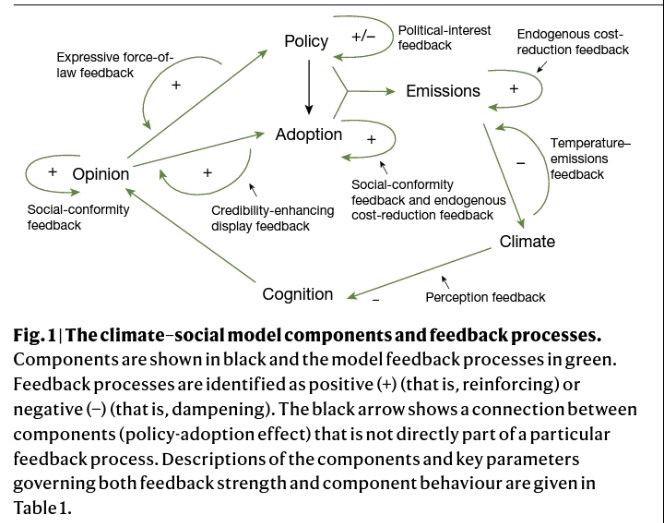The global trajectory of anthropogenic greenhouse gas emissions is the most important determinant of projected global temperature increases in this century and beyond, swamping the magnitude of internal climate variability or model differences1. However, this key driver of Earth’s future climate is treated as exogenous in almost all climate science3. Moreover, although emissions pathways arise from complex interactions among social, political, economic and technical systems, these elements are often analysed separately within disciplinary silos, neglecting interactions and feedback that can give rise to or stymie rapid change5. Understanding the potential for nonlinear dynamics in the socio-technical systems producing both greenhouse gases and climate policy is essential for identifying high-impact intervention points and better informing policy4,6,7. However, the coupling and interaction among social, political, economic, technical and climate systems—and their implications for emissions and temperature trajectories over the twenty-first century—have not been widely examined (although refs. 2,8,9 provide some exceptions).
Evidence regarding the likely emissions path over the twenty-first century is mixed. On the one hand, although emissions growth may have decelerated in recent years, with some evidence of declining emissions in a few advanced economies, global emissions continue to grow10. National commitments under the Paris Agreement remain inadequate to meet either the 1.5-°C or 2-°C temperature target11 and it is unclear whether government policies are yet sufficient to deliver on these emissions pledges12. Carbon dioxide emissions from energy infrastructure currently in place or under development will exceed the 1.5-°C carbon budget, and standard energy-system models struggle to simulate pathways that meet either temperature target without the widespread deployment of negative emissions technologies that are highly speculative13,14,15. The pace of decarbonization that is required to meet the Paris temperature targets vastly exceeds anything in the historical record at the global scale16.

On the other hand, specific cases of very rapid change in energy systems do exist, with accelerating deployment as market or policy conditions shift and technology costs fall. Path dependencies, increasing returns to scale and learning-by-doing cost reductions can produce sudden, tipping-point-like transitions that cannot be extrapolated from past system behaviour17,18. Recent examples include the rapid fall in coal generation in the UK electricity mix and the dominance of electric vehicles sales in Norway19,20. Standard energy models, which mostly rely on linear extrapolations of past behaviour, repeatedly underpredict the rate of renewable energy growth21. Historically, technological innovation and government policies often motivated by energy security concerns22 have also, in notable cases, spurred rapid shifts in energy systems, one of the fastest examples of which being the transition to kerosene lighting in the nineteenth century23.
Social norms that shape individual behaviour and preferences can exhibit similar tipping-point style dynamics24. These changes, via collective action operating though political institutions, could in turn affect the regulatory and market conditions in which energy technologies compete. The presence of both positive and negative feedback processes within the political system has also been documented, as policy changes can both create new interest groups and activate incumbents against further change25,26,27.
These coupled feedback processes could give rise to complex behaviour and a wide range of plausible emissions pathways but, although the space of possibility is wide, that does not mean it is unknowable. Our goal is to model the drivers of potential emissions scenarios over the twenty-first century and, in doing so, shed light on how both climate policy and emissions arise from more fundamental socio-politico-technical forces and the key parameters governing these dynamics.
The main contributions are threefold. First, we present a stylized model of the coupled climate–social system, focusing on coupling across individual to global scales and on feedback processes documented across a wide range of relevant disciplinary literatures. This model is distinct from previous work that represents feedback processes within energy systems28 or between the climate, the economy and emissions pathways29 in that climate policy is still specified exogenously in these applications. By contrast, in this model, climate policy and greenhouse gas emissions arise endogenously from the coupled interaction of the climate, social, political and energy systems.
Second, we used this model to systematically examine potential dynamics of the system, highlighting feedback, connections and thresholds across different components. Finally, after partially constraining the set of parameter values using historical data, we examined the space of possible emissions and policy trajectories over the twenty-first century arising from the model. These fall into five clusters associated with particular parameter combinations, enabling these future trajectories to be classified on the basis of their underlying social, political and technical characteristics. Overall, we find that the socio-politico-technical feedback processes can be decisive determinants of climate policy and emissions futures. Our parameterized model implies a high likelihood of accelerating emissions reductions over the twenty-first century, moving the world decisively away from a no-policy, business-as-usual baseline.









